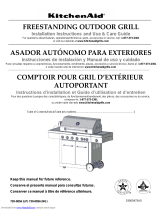2
TABLE OF CONTENTS
OUTDOOR GRILL SAFETY………………….……..…………3
INSTALLATION REQUIREMENTS……………………………..5
Tools and Parts………………………………………...……….…5
Location Requirements………………………………………...…5
Product Dimensions………………………………..……….…….6
Built-In Outdoor Grill Enclosure………………………………….6
Cabinet Cutout Dimensions………………………………………7
Gas Supply Requirements…………………..…..……………..…8
Gas Connection Requirements…………………..…..………..…9
INSTALLATION INSTRUCTIONS……………..............…...10
Unpack Grill……………..…………………......………………...10
Install Grill………………..…………………......………………...11
Make Gas Connection…………………….............……………12
GAS CONVERSIONS……………….................................…...13
Conversion from LP Gas to Natural Gas…....………………...14
Make Gas Connection …...……………….............……………14
Check and Adjust the Burners ………..………….………….…17
OUTDOOR GRILL USE ………………….………………..…18
Using Your Outdoor Grill ……………………….…………….…18
Using Your Rotisserie Burner……………………………..……21
TIPS FOR OUTDOOR GRILLING ……………..……………...22
Cooking Methods ………………….…………………………….22
Rotisserie Cooking Tips … ………….………………...…….….23
Grilling Chart ………………………….………………...…….….24
OUTDOOR GRILL CARE ………………………………...……26
Replacing the Igniter Battery …….…………………..……....26
General Cleaning ……………………………………….….....…26
TROUBLESHOOTING ...........................................................28
ASSISTANCE …………………………………………….…..…28
Accessories………………………………………………...……..28
WARRANTY ……………………………………….…………….29
REPLACEMENT PARTS………………………………...….…93
TABLE DES MATIÈRES
SÉCURITÉ DU GRIL D'EXTÉRIEUR….………..…….…….…31
EXIGENCES D’INSTALLATION…….……………..….....….33
Outils et pièces……….………….……..………........…..………33
Exigences d'emplacement…………….….………....….………33
Dimensions du produit ……………………………………...…..34
Enceinte du gril d'extérieur encastré…………………….…….34
Dimensions de l'ouverture à découper dans le placard……..35
Spécifications de l'alimentation en gaz………………..………36
Exigences concernant le raccordement au gaz………………38
INSTRUCTIONS D’INSTALLATION……………....................39
Déballage du gril………………………………………………....39
Installation du gril…………………………………….…………..40
Raccordement au gaz………………………………….….….…41
CONVERSIONS POUR CHANGEMENT DE GAZ ……...…..42
Outils et pièces pour conversion de gaz ………….………....42
Conversion de propane à gaz naturel ……………….…...…...43
Raccordement au gaz …………………………............…....….43
Contrôle et réglage des brûleurs ………………………….…...47
UTILISATION DU GRIL D’EXTÉRIEUR …….………..……...48
Utilisation de votre gril d'extérieur….….……….……..……….48
Utilisation du brûleur de tournebroche…………..……..……...48
CONSEILS POUR L'UTILISATION DU GRIL
D’EXTÉRIEUR………….…………..…...….……......…...……..49
Méthodes de cuisson….………………..……….…...……….…49
Conseils de cuisson à l’aide du tournebroche……….….……53
Tableau de cuisson au gril …………………………..……...….54
ENTRETIEN DU GRIL D’EXTÉRIEUR …………..…………...56
Remplacement de la pile de l’allumeur ……..…...………….56
Nettoage général ………………………………...……….…….56
DÉPANNAGE..........................................................................58
ASSISTANCE………………………………….…..………….…58
Accessoires………………………………………………...……..58
GARANTIE……………………………………..……..……...…..59
PIÈCES DE RECHANGE …………………..………………...94
ÍNDICE
SEGURIDAD DEL ASADOR PARA EXTERIORES…...........61
REQUISITOS DE INSTALACIÓN…………..………………....63
Herramientas y piezas….……………………………..…………63
Requisitos de ubicación.…………………………….….……....63
Medidas del producto……………………………….…………..64
Recinto del asador empotrado para exteriores…………........64
Dimensiones del corte del armario…………………………..…65
Requisitos del suministro de gas……………………………….66
Requisitos para la conexión de gas……………………………68
INSTRUCCIONES DE INSTALACIÓN………………..………69
Desempaque el asador………………………………………….69
Instalación del asador……………………………………………70
Conexión del suministro de gas….…………………………….71
CONVERSIONES DE GAS………………………......………73
Conversión de gas LP a gas natural……….…………..………74
Conexión del suministro de gas…………………………..……74
Revise y regule los quemadores………….…………….....…...78
USO DEL ASADOR PARA EXTERIORES…….….………..79
Cómo usar el asador para exteriores…………….……....…....79
Uso del quemador del rostizador…......…...…..….…………...82
CONSEJOS PARA ASAR AL AIRE LIBRE…….……...…..83
Métodos de cocción…………….…….…………………....…...83
Consejos para la cocción con el rostizador…….………....….84
Cuadro para asar…………………………………………………85
CUIDADO DEL ASADOR PARA EXTERIORES….....…….87
Cómo reemplazar labatería del encendedor………….....……87
Limpieza general …………………………………………..…….87
SOLUCIÓN DE PROBLEMAS...............................................89
ASISTENCIA…………………………………………..……..…..89
Accesorios….……………………………………………...……..89
GARANTÍA ……………………………………………..……......90
PIEZAS DE REPUESTO ………………………….............…95





















